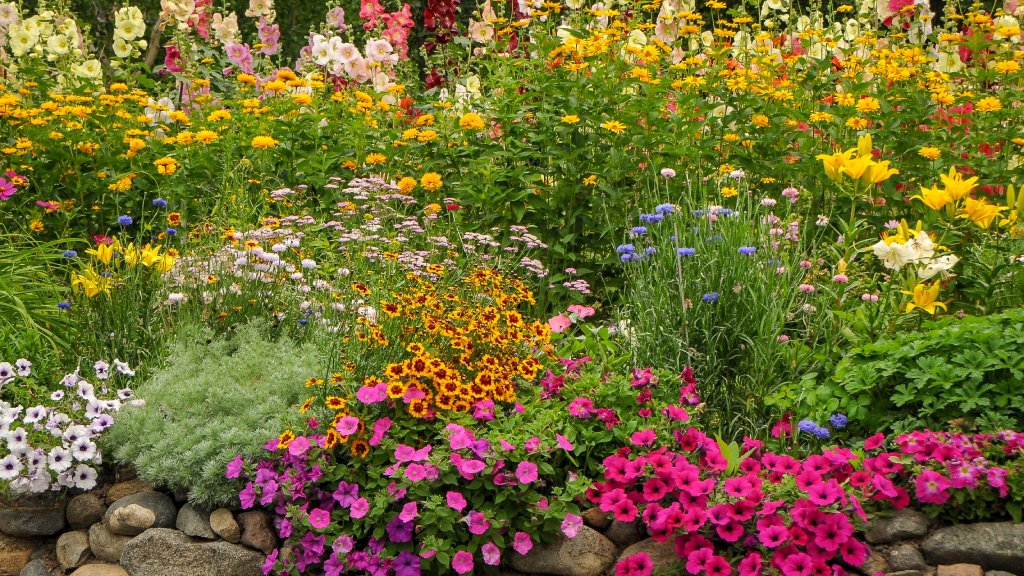Chaos Gardening: How To Try The Wild New Gardening Trend
Chaos gardening is a fun hobby that’s natural and beneficial for lazy gardeners, insects and wildlife.


Many gardeners dream of a manicured yard, fields of perfect flowers, straight rows of veggies, and neatly trimmed hedges. Such a vision takes a lot of effort, but what about trying chaos gardening?
What is chaos gardening? Chaos gardens are a recent trend, with gardeners taking a more relaxed approach to the hobby. While the practice might be too much for the general landscape, a chaos vegetable garden will still grow prize-winning squash, just with a lot less effort.
What Is Chaos Gardening?
Chaos gardening mimics the way nature grows. It is a practice of blending playfulness with natural structure. In the wild, plants are not growing in rows, or organized in any way. They grow in uncontrolled disorder wherever a bird drops a seed, or a plant produces offsets. Utilizing this concept, the gardener allows the garden to develop its own personality, style, and design. As plants mingle in whatever manner they wish, a huge diversity develops. While the gardener is the ultimate architect of which plants come into the landscape, chaos gardening dictates random placement and an unstructured design.
Benefits of Chaos Gardening
One of the more obvious chaos gardening benefits is the ease with which it is practiced. Essentially it is a “lazy” way to garden. Rather than spending a lot of time edging, weeding, and manicuring all aspects of the landscape, more time is spent simply enjoying the unfettered growth and rangy wildness of the garden. When plants are left to themselves, a moving, everchanging garden is formed. The effect provides seasonal drama over the year and a rich tapestry of form, color, and movement.
Another benefit to chaos gardening is the habitat it creates for animals, birds, and beneficial insects. Food, cover, nesting sites, nurseries, and more opportunities exist in the chaos landscape. Allowing seeds, flowers, and other plants to thrive in the situation they are in rather than forcing them to exist in inopportune spots will encourage a healthier garden that supports itself.
How to Grow a Chaos Garden
If you just want to dip a toe into the chaos garden concept, starting with seeds is the easiest and least daunting method. Mix all your leftover seeds, vegetables, herbs, and flowers, and randomly sow them. This is a bit experimental, but that is half the fun. Whatever comes up and thrives in the area will define the bed. It may be that only flowers come up, or the garden may sport vegetables intermixed with blooms.
Another way to start is to simply choose a bunch of your favorite plants. Make sure they all enjoy the same growing conditions and then plant them in no particular order. The resulting cacophony of textures and hues is much like how nature develops. The only rule might be to place the larger plants behind the smaller ones so they can all be displayed.
Gardening tips, videos, info and more delivered right to your inbox!
Sign up for the Gardening Know How newsletter today and receive a free copy of our e-book "How to Grow Delicious Tomatoes".
Plants to Include in Your Chaos Garden
The sky's the limit as to which plants can be grown in a chaos garden. For even less maintenance, perhaps select only native plants that are adapted to the region. These will further enhance and attract wildlife habitat. If you prefer several seasons of blooms, focus on bulbs, roses, perennials, and annual flower specimens. Add larger plants to provide spaces for birds, shade, and windbreaks. Layer the plantings and allow plants to self-sow and grow the way they want.
Maintaining a Chaos Garden
No matter how wild and unruly the garden will become, it will still require some nurturing. Prune to remove broken or diseased stems. Water the plants when necessary. Provide them with nutrient-rich soil and enrich it annually. Take seed heads and strew them randomly, providing even more opportunity for future plants. Harvest and make use of any food crops. Share excess with animals and neighbors, and save seed for the next year. Consider installing pathways that will allow ease of maintenance. Above all, enjoy the evolving landscape which will change season by season, and year by year.

Bonnie Grant is a professional landscaper with a Certification in Urban Gardening. She has been gardening and writing for 15 years. A former professional chef, she has a passion for edible landscaping.
-
 Looking For Plants To Give You The Soft And Fuzzies? Try These 5 Fuzzy Leaf Plant Options
Looking For Plants To Give You The Soft And Fuzzies? Try These 5 Fuzzy Leaf Plant OptionsLovers of texture, drama, silver foliage and tactile plants will adore these special sensory garden additions. These fuzzy leaf plant options will leave you all aglow
By Susan Albert
-
 Get Ready For A Summer Of Hummers! Grow These Full Sun Hummingbird Plants and Flowers
Get Ready For A Summer Of Hummers! Grow These Full Sun Hummingbird Plants and FlowersIf you’re lucky enough to enjoy a sunny backyard, make sure you are maxing out on your pollinator opportunities and grow these full sun hummingbird plants and flowers
By Tonya Barnett